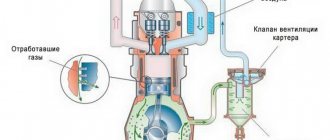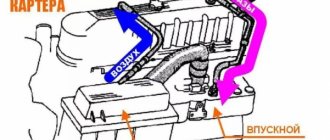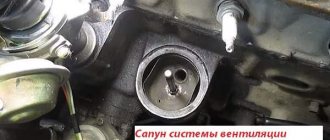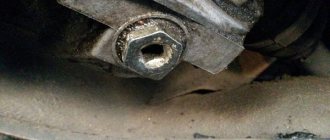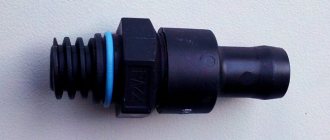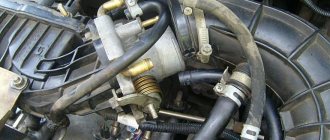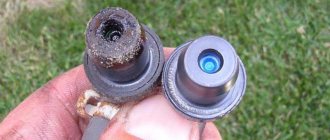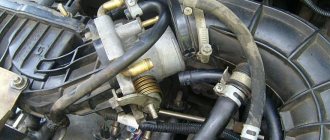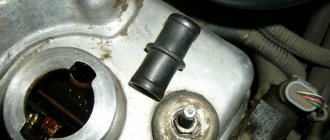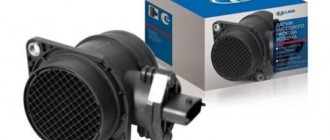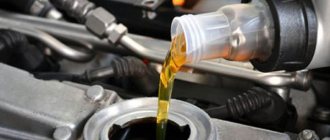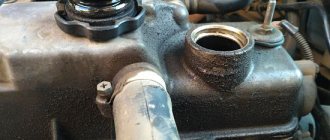Regular cleaning of crankcase ventilation improves engine performance, which depends on the amount of gases in the crankcase, as well as on their correct removal and supply to the fuel system. Cleaning is carried out when disassembling the system using detergents, a selection of which is offered at specialized stations and shops for motorists.
The removal of harmful gases from the crankcase is mandatory for all internal combustion engines.
Purpose of the crankcase gas exhaust system
When the air-fuel mixture burns, enormous pressure is created in the cylinder. Therefore, even on a working engine, some of the exhaust gases inevitably break through the piston rings into the crankcase. Also, diesel fuel and gasoline vapors enter the sump from the combustion chamber through the rings on the compression stroke and during incomplete combustion of the fuel injection pump.
During operation, a mixture of oil vapor, gasoline, exhaust gases and water vapor creates increased pressure in the crankcase space. If you do not remove this explosive mixture, the pressure will not only interfere with the removal of oil from the cylinder walls, but will also squeeze out the crankshaft and camshaft seals.
According to environmental standards, all modern cars must be equipped with a closed crankcase ventilation system. This means that the mixture of vapors and exhaust gases is fed back into the intake manifold.
Cleaning steps
If the crankcase ventilation system is completely clogged, you will notice very unpleasant symptoms. These include:
- engine power decreases;
- an increase in fuel consumption, which is especially noticeable during urban travel;
- periodic loss of the accelerator pedal;
- Small drops of oil are noticeable on the gasket and cuffs of the engine crankcase.
You can remove blockages and clean the ventilation system using several methods.
For example, first of all, it is recommended to check the condition of all working elements of the oil separator and valve for the presence of various deposits of combustion products. Even if no accumulation is noticeable, it won’t hurt to do a little cleaning.
If after this the symptoms of clogging do not disappear, you will have to wash the damper rod
Experts point out that after washing, the damper must be thoroughly wiped dry. Under no circumstances should it be lubricated.
Cleaning the crankcase ventilation system is carried out in the following sequence:
- Remove the cylinder head cover.
- Remove all the screens located in the cylinder head cover.
- Wash all screens, oil separator housing and BC head cover. You can use kerosene for this. It is necessary to ensure that kerosene does not remain in the crankcase. If this cannot be avoided, you will have to completely change the crankcase oil.
- Install the grids by carefully turning them in the lid. On one side, the mesh should rest against the protrusion on the crankcase cover, and on the other, the hole on the oil separator body should be visible.
- Tighten the mounting bolts.
- Check the condition of the SVK cover gaskets. If wear or clogging is noticeable, the gaskets must be replaced.
- Install the cover on the cylinder head.
To do this job yourself, you need to have the right tools. These include:
- Core. With its help, channels are checked for the presence of deposits or blockages on their walls.
- A rod with a high degree of flexibility. Its use facilitates access to hard-to-reach areas of the system located horizontally.
- Brush machine. If this is not available, a hand brush can be used to remove deposits and blockages just as effectively.
- Channel punch. With its help, you can simplify the removal of blockages. To create punches, you can use brick or any construction waste.
If we talk about the frequency of cleaning the crankcase ventilation system, it depends on the engine system. The optimal cleaning period is once every 6-7 months. If the vehicle is used frequently, the period must be reduced to 4 - 5 months.
Fine fuel filters serve as a guide to the need for cleaning. As soon as dirt or deposits become noticeable on their walls, it’s time to start cleaning the HVAC.
System design
The features of the device and operating principle of the system depend on the specific engine model, but a typical design involves the presence of a crankcase ventilation valve, pipes and an oil separator.
Principle of operation
Exhaust gases mixed with gasoline vapors flow to the oil separator due to the resulting pressure. In the oil trap body, fine oil particles collect on the walls of the filter element. The resulting drops, under the influence of gravity, flow into the oil sump, and the filtered gases enter the intake manifold through the crankcase ventilation valve.
The design of the system presented above assumes the presence of an intercooler, which serves to cool the air flow. The need to reduce the temperature is determined not so much by the operation of the crankcase ventilation, but by the features of the turbocharging system, which is equipped with the TDI engine shown in the diagram.
Oil particles deposited on the walls of the intake tract lead to a decrease in the service life of the mass air flow sensor, pressure regulator, air pressure regulator, and contribute to contamination of the throttle assembly and IAC. For intake manifolds with exhaust flaps, the danger is also that the oil film collects particles of dust and soot, which act as an abrasive for the flap drive. Therefore, most modern crankcase ventilation systems are equipped with an oil trap.
Thread separation
The standard crankcase ventilation system has two pipes for supplying gases to the intake tract. This is due to the difference in pressure in front of the throttle and in the space behind the throttle. In minimum load mode, when the throttle valve is barely open, the flow area is minimal, so the greatest vacuum is in the throttle space. In heavy and full load modes, an open throttle valve does not create significant resistance to the flow of air, so the vacuum in the intake tract is minimal. Separation of entry points allows flexible dosing of crankcase gases.
Oil catcher
The most widespread are cyclic and labyrinth filtration methods. Most modern crankcase ventilation systems use both methods of oil separation.
The labyrinth method acts as a coarse filtration stage and serves to separate large oil particles. The principle of operation of the catcher is to pass the flow of crankcase gases through a channel with oil deflector plates. In contact with the plates, large particles settle on the walls, after which they flow into the return oil line.
At the fine cleaning stage, crankcase gases pass through a cyclic (centrifugal) oil separator. The operating principle is based on the passage of gases around the circumference of the separator body. Under the influence of centrifugal forces, oil droplets, the mass of which is greater than the mass of the exhaust gases, are displaced outward and settle on the wall. After separation, the smallest particles of oil flow into the return line.
To reduce the harmful effects of turbulence of gas flows at the entrance to the air path, the design of a system of this type assumes the presence of an output stilling chamber. Thanks to it, after passing through the centrifugal oil separator, the kinetic energy of the gas is reduced. In addition, fine particles of motor oil also settle on the walls of the chamber.
Some crankcase ventilation systems use a synthetic filter element. When crankcase gases pass through it, oil particles settle on the fibers, collect into large drops and flow into the return line.
PCV valve
The crankcase ventilation system valve is necessary to limit the vacuum. High vacuum, as well as excess pressure, can damage the seals. Therefore, the PCV valve allows crankcase gases to enter as the vacuum in the intake manifold drops.
In normal condition, the valve is held open by a return spring. When the engine is idling, the vacuum overcomes the spring force and closes the channel connecting the engine crankcase and the intake manifold. Accordingly, as the throttle valve opens and the vacuum decreases, the return spring slightly opens the channel for gas access.
On many VAG vehicles with a two-stage filtration system, the PCV valve's job is to interrupt the flow from the coarse stage to the fine stage.
Symptoms of malfunction
Signs of improper crankcase ventilation:
- increased oil consumption;
- excessive fogging in places where oil seals, cylinder head gaskets, cylinder head gaskets, and pans are installed. As the cylinder-piston group of the engine wears out, the amount of gases breaking into the crankcase increases, so the load on the system increases. But symptoms of high crankcase pressure can also manifest themselves in a working car. During the frosty season, condensation accumulates in the system pipes, which, when frozen, completely blocks the crankcase ventilation. In this case, a dipstick is often saved from damage to the seals by pushing it out of the seat;
- The engine is shaking, the speed is fluctuating. The reason is a leak in the valve or the line from the valve to the intake manifold, due to which unaccounted air is sucked in;
- engine oil in the air filter, intake pipe. The reason is a clogged filter element;
- When parking and driving at low speeds, the air conditioning system sucks exhaust gases into the cabin. The car's pipes from the crankcase to the PCV valve are leaking, causing the engine compartment to become saturated with exhaust gases.
What the engine crankcase ventilation system is designed for is clear from its name. But why does the crankcase need to be ventilated? As practice shows, the accuracy of the answer to this question greatly depends on whether one or another owner has previously had to deal with the problems that the ventilation system can create. If you haven’t, it happens that the car owner may not even know why the crankcase needs ventilation, as well as how it is implemented.
It all comes down to the breakthrough of gases into the crankcase. No matter how good the piston rings are, they cannot provide complete sealing of the space above the piston where the working process occurs. As a result, under the influence of high pressure, not only the combustion products of the combustible mixture penetrate into the crankcase from the space above the piston, but also some of the combustible mixture itself during the compression stroke.
Ventilation cleaning procedure
Cleaning the crankcase ventilation is carried out as follows:
open the hood and disconnect the ABC terminals (this is necessary to ensure that the reading work is completed safely);- carefully remove the pipe that goes to the air collector;
- now you need to unscrew the self-tapping screw, and then remove the casing from the throttle valve (the self-tapping screw will be visible after removing the pipe, so unscrewing it will not be difficult);
- disconnect the injectors, and then move the cable where the connectors are located to the side;
- unscrew the bolts, fasteners that hold the dipstick and the upper part of the bracket responsible for finding the intake manifold;
- remove the tube located in the oil dipstick from the engine - this must be done strictly from the “up” position;
- Now you should remove the ramp cover, which covers the injectors and their connectors (to avoid difficulties, the manipulation is carried out with a sharp movement).
The first part of the “procedure” is completed.
Now let's move on to the second one:
disconnect the fuel line from the ramp (it is important to note that its connection is different on different brands of cars);- make the damper clamp a little weaker, and then carefully remove it;
- in the same way you need to remove the pipe from the fitting (since the fitting is plastic, this is done extremely carefully);
- disconnect all XX connectors;
- remove the throttle cable from the damper, which will interfere with cleaning;
- We disconnect the bayonet connection from the “trunk” pulled out from the engine;
- remove the lid from the wells intended for candles;
- remove the valve hose, then unscrew the 4 bolts located on the top of the manifold;
- Now you should slightly loosen, but not completely remove the lower bolts (there are 5 of them), and then remove the manifold;
- slightly disconnect the clamps, and then remove the ventilation hoses from the oil separator box;
- Unscrew the remaining bolts, and then disconnect the engine block and the oil separator.
That's it - the preparatory stage of work is completely completed. Now you can begin removing the putty, as well as cleaning and washing the oil separator cavity. It should be washed until the resins are completely gone from its base.
If the contamination is too strong, it is necessary to completely replace the oil separator, since it is quite difficult to wash it. In addition, a poorly cleaned part can provoke the rapid growth of new contamination.
After cleaning, we check the hoses located on the flame arrester and crankcase ventilation. If the throttle valve is dirty, it should also be washed.
How does the engine crankcase work and what is it for?
This box-type element is designed to protect and support the internal combustion engine elements; it also serves as an oil reservoir. The lower part includes a container for collecting gases and a pan with oil. The top contains the valve cover, cylinder block and cylinder head.
Modern crankcase models include more than 10 elements. In medium and large-sized engines, its parts are racks connected to each other. Only modifications for small motors have a solid body.
Cost of the KG ventilation valve
The cost of KVKG can be completely different; the price largely depends on the car model and the engine itself. For example, an original valve for an M54 (BMW) internal combustion engine costs about 2200-2400 rubles; this device is also suitable for M52 series engines and is installed on E39 5-series cars, X3, X5, BMW Compact. For Ford cars (Duratec HE engines), a ventilation valve can be purchased at an average price of 1300-1800 rubles, the cost depends on the seller - custom parts are cheaper if the parts are not needed urgently.
What are crankcase gases
During operation of the internal combustion engine, high pressure is formed inside the cylinder. During combustion of the air-fuel mixture, exhaust gases partially break through the piston rings and penetrate into the crankcase cavity. When gasoline burns incompletely and during the compression stroke, fuel, oil, and water vapors also enter the crankcase.
All these gases are collectively called crankcase gases. When they accumulate, the pressure in the crankcase increases, and the side effect is accelerated engine wear. There is also dilution and deterioration in the quality of the engine oil.
About the crankcase ventilation system
To avoid the accumulation of gases and increased pressure, the machines are equipped with a closed-type ventilation system. The principle of its operation is based on the removal of accumulated gases into the intake manifold.
The principle of operation can be based on the removal of gases, or on the influx of clean air. Nowadays the most common model is the combined type. This unit consists of four parts:
- Oil separator - removes oil particles that should not enter the combustion chamber.
- Air pipes.
- Valve - regulates pressure,
- Dampener - helps prevent vapor turbulence.
Closed crankcase ventilation system
What to clean with?
Specialized service stations offer a wide range of cleaning products that do not damage mechanisms or disturb their structure and coating. But when cleaning yourself, chemicals containing acid are sometimes used, which effectively remove carbon deposits, deposits, soot and other harmful substances, but at the same time destroy the structure of the material. Therefore, when cleaning outside a service station, it is also necessary to use liquids offered in specialized stores.
Causes of ventilation malfunction
The problem is most often caused by poor conductivity of the system or its depressurization. The main reasons for such problems are given in the list:
- Various damage to hoses.
- PCV valve diaphragm rupture.
- Clogged ventilation system hoses.
- Carbon deposits - Even processed gases contain oil particles. As a result of the constant movement of vapors, contaminants accumulate on the surface of the valve.
- Wear of the piston group.
Ozone method
An excellent solution for ecology lovers. Ozone has very strong disinfectant properties and copes well with fungi and all microbes. What does the ozonation process look like? At the very beginning, you need to thoroughly vacuum the vehicle to get rid of any dirt.
The entire disinfection process occurs thanks to an ozone generator. Its use causes the oxygen molecule to split into two separate oxygen atoms. As a result of this reaction, O3 is formed, which then oxidizes any chemical composition. Ozone circulates, as a result of which all fungi and microbes die, and the unpleasant odor disappears. In the end, you just need to ventilate the Renault Logan 2.
How to detect ventilation problems
When the ventilation system becomes clogged, gases stop being released normally. Resinous deposits form, interfering with the removal of vapors. The following manifestations of the problem are possible:
- Leaks and excessive oil consumption.
- The oil in the sump can be sucked in through the valve. This leads to valve deformation.
- Possible engine smoke.
- Deterioration of engine dynamics.
- Extraneous sounds in the valve and intake manifold area.
- The idle air control and throttle valve become dirty too quickly.
- If the system is severely clogged, crankcase gases pull out the dipstick.
Replacing KVKG
Replacing a valve is easy on almost any passenger car, but each SVKG engine model has its own design features. Let us consider, as an example, how the KVKG changes on the M54 B22 engine, the make of the car is a BMW fifth series in the back of an E39. The KVKG valve is located under the intake manifold at the front of the internal combustion engine, and to get to it you need to remove:
- electronic throttle;
- idle speed controller.
For convenience, you can remove the intake manifold itself, but then the work turns out to be quite labor-intensive, and you will also have to purchase manifold gaskets. After access to the valve is ensured, disconnect the hoses from the KVKG and dismantle the device itself. We are installing a new mechanism, putting all the parts in their places.
How to avoid system breakdown
For the ventilation system to work properly, it is important to use high-quality oil. Ventilation also needs to be cleaned. The procedure for carrying out preventive cleaning is described below:
- Disconnect the expansion tank. Disconnect the block pipe and the wire connected to the sensor.
- The tube leading to the block is plugged, the tank is installed vertically.
- Disconnect the throttle valve, and then the tube going to the block. The block is pulled out.
- Remove the breather clamps.
- Disconnect valves from units being cleaned.
- Clean it, then reassemble the parts in the reverse order.
What internal and external factors affect ventilation wear
Clogged hoses cause the seals to squeeze out. Due to the increased pressure, oil flows through the crankshaft and valve cover seals. The probes may fly out.
Worn out ventilation system
When hoses are damaged, air may be drawn in. This leads to a decrease in dynamic characteristics. The valve sends gases to the engine, and carbon deposits along with oil clog the throttle valve. During repairs, the brackets cannot be removed; due to them, the hose is fixed at an angle. Otherwise, the condensate formed in winter will not be able to drain, but will freeze and clog the line.
Possible malfunctions, their diagnosis
Crankcase ventilation problems, as a rule, are not obvious, but until a complete blockage of some part of the exhaust gas exhaust air path occurs, such as a fitting, a rubber hose, part of the internal space of the oil separator or the valve mechanism itself.
Such a fatal malfunction will cause a frankly poorly running engine, or due to increased internal pressure it will simply squeeze out oil through the rubber gaskets of the oil pan and valve cover. In this case, simply washing the oil separator and valve will not solve the problem, as a complete cleaning of the crankcase ventilation system will be required.
However, before the crankcase ventilation elements are completely clogged, the following symptoms must begin to appear:
- gradual reduction in engine power;
- a slight increase in fuel consumption, especially in the urban cycle;
- failures in the accelerator pedal;
- the appearance of oil release on the gaskets and cuffs of the engine housing.
Methods for checking crankcase gases
It is necessary to open the cover on the hood and unscrew the oil filler cap, but do not unscrew it completely and remove it. Next you need to start the engine and see what happens to the cover:
If it jumps but doesn’t fly off, it means there is pressure and gases are escaping. This is fine.
When discharged, the cover suctions, this indicates problems with the intake manifold. In this case, a vacuum is created in the crankcase.
When it is thrown up strongly, this phenomenon means that the rings have sagged.
The second diagnostic method is to start the engine and open the lid completely. If it sticks slightly during removal, then the ventilation is working properly. When the suction is too weak and smoke comes out of the neck, this indicates a failure.
A lid that suctions too tightly is also a sign of failure. Most likely, the valve is leaking because its membrane is damaged. If, while the engine is running, oil splashes from under the cap and flows through the injectors, a major overhaul may be required. Such problems usually occur on cars with high mileage and a worn-out engine.
The third method will give results if the system is heavily clogged. You need to start the car and remove the dipstick. The engine is considered to be operating properly when a slight suction is felt when plugging the dipstick hole. If smoke appears, the mechanism is faulty.
Checking with a balloon
This technique is used with muffled ventilation. It is necessary to remove the oil dipstick from the tube. Then a balloon or medical glove is put on it and secured with electrical tape. You can also put it in place of the filler plug, but then you will have to make sure that the ball does not get sucked inside.
Next, start the engine, at minimum speed in idle mode, the ball should inflate slightly and stop.
When within 5 minutes the balloon hardly increases in size or inflates too much, this means that the ventilation is clogged and is working poorly. The piston rings may be worn out.
It happens that the ball stops increasing in size when the plugs are installed. This means that you will have to disassemble the system and see which element is clogged.
To check the functionality of the valve, clamp the tube forcefully with the engine running. If a click is heard at the moment of compression, the element is working properly. Another option is to hold a piece of paper over the flap. The leaf should float in the air under the influence of gases. If you put it over the hole, it will be attracted.
What are valve malfunctions?
The presence of a malfunction can be determined by its characteristic symptoms.
- Oil splashing and increased oil consumption.
- Filter dirty.
- The engine does not start at full power or you can hear a slight whine from the engine.
Basic malfunctions.
- The valve and membrane are dirty.
- Exhaust openings and pipes are dirty.
- The membrane has worn out and flattened.
Crankcase gases are usually not completely released from the oil in the oil purifier. All components of the system - membranes, pipes, valves - become dirty and clogged with oil soot. If the driver does not take the time to clean them, the crankcase pressure increases. A strong smell, burning and soot appears when the engine is running. You may notice that oil consumption increases. When a valve fails, oil pressure increases and is forced past the seals and gaskets.
Valve wear is also characterized by a decrease in engine power. In this case, the pressure in the exhaust system increases or even the operation of the internal combustion engine stops completely. If the damaged valve is not completely blocked by the membrane, then oxygen entering the combustion chamber will help the engine fail.
Crankcase gas measuring device
You can measure pressure with a monometer; normal readings should not exceed 60 millimeters of mercury. First, make sure there is no blockage in the breather tube. Also check the engine oil level. The model of the measuring device is selected based on the power and type of engine. It is important to ensure that the device fits the diameter of the calibrated hole.
On vehicles with a closed ventilation system, the breather tube must be disconnected. A plug is placed on the channel inside the intake manifold. A pressure gauge is attached to the tip of the tube. A pressure sensor is connected to the device itself.
The engine must be operated at the load and speed at which the rated power is achieved. You need to wait until the pressure gauge readings level out.
After the device has stabilized, the results are recorded. You can then remove the device, pull out the plug and reconnect the tube.
It is important to consider that gas consumption may differ on two engines with the same displacement. This situation is possible when the models under consideration are differentiated by performance indicators per unit of time and torque.
| SHARE: |
Double-sided adhesive foam method
The easiest and cheapest way that even a beginner can do. It is enough to purchase a special antifungal spray, which is available at any automotive store and most supermarkets. Most often, a special device is attached to it, with the help of which the spray is introduced through the channels in the direction of the evaporator. Simply inject the product inside to destroy all bacteria and fungi.
Unfortunately, this method has its drawbacks. We are not 100% sure that the mold has died. We cannot see whether the tube being used reaches deep enough to clean the entire air conditioner. Dripping foam can also cause a short circuit.
When is crankcase ventilation diagnostics required?
When the car is in good working order, the check does not need to be carried out. But after a major overhaul of the engine, such a procedure is mandatory. It allows you to verify the exact geometric correspondence of the selected parts. It is recommended to carry out an inspection if there is a suspiciously high oil consumption in machines with open ventilation systems.
If the system is closed, diagnostics are carried out when oil enters the intake manifold. This operation can be performed to detect engine damage. For example, problems are often caused by worn valve stem seals or piston rings.
The ventilation can last quite a long time, as it has a simple design. Usually there are only two breakdowns, the first is that the valve cover separators become clogged. The second option is valve failure.
The valve operates in several modes, and its position depends on the condition of the engine. At idle, it opens partially and does not allow gases to pass through completely. As the throttle valve opens, the gap increases.
When the engine is turned off, the gap closes completely. If the valve becomes coked or bursts, it begins to work incorrectly. In such a situation, it is always open or, conversely, closed.
| Ventilation valve operation | ||||
| Motor condition | Stopped | Idling | Normal operation | High load and acceleration |
| Valve position | ||||
| PCV valve | Closed | Ajar | Normally open | Fully open |
| Vacuum in the intake manifold | Absent | High | Average | Low |
| Crankcase gas flow | Absent | Small | Average | Big |
Do-it-yourself Renault Logan repair: what work will be required?
The Service Manual contains complete information on operating a Reno vehicle:
- Body repair, cleaning of deflectors and sunroof built into the roof of the car.
- Monitoring the condition of the engine, draining fluid from the filter device and scheduled work.
- Clutch maintenance (checking and adjusting free play, replacing faulty components).
- Determination of the wear level of brake discs and pads, the condition of the hydraulic drive and the volume of brake fluid.
- Checking the steering system, windshield washer and hydraulic unit.
- Technical control of shock absorbers and chassis elements.
- Monitoring the performance of lighting devices, windshield wiper blades, and rear-view mirrors.
- DIY ECU diagnostics.
- Checking light bulbs and battery voltage levels.
In what cases is the presence of oil in the breather not related to the crankcase?
Before diagnosis, it is recommended to make sure that the unpleasant symptoms are actually associated with gases. Oil ingress is also possible in other cases, for example, if more fluid is poured than required according to the standards. It is possible that the breather is not installed correctly and moving it will correct the problem.
Sometimes oil penetrates from the internal elements of the power unit, including injectors. Driving style, as well as the condition of the roadway, also influences. Oil particles may remain when the motor actively moves in the transverse direction.
